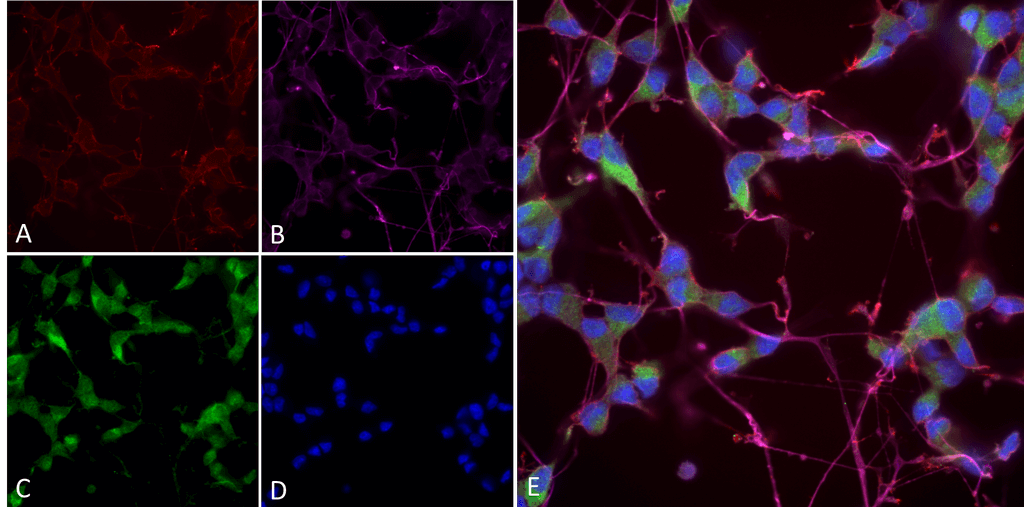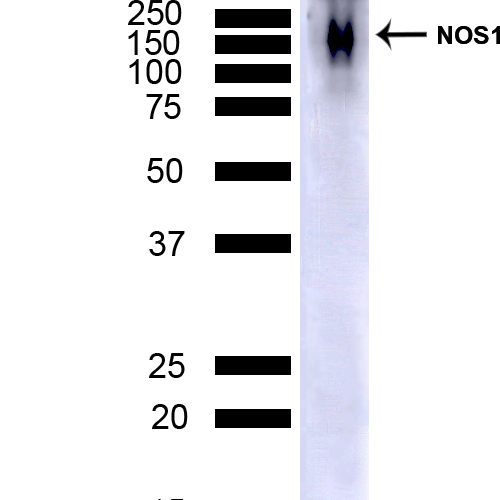NOS1/ nNOS Antibody
NOS1/ nNOS Antibody
- SPECIFICATION
- CITATIONS
- PROTOCOLS
- BACKGROUND

| Primary Accession | P29475 |
|---|---|
| Other Accession | NP_000611.1 |
| Host | Mouse |
| Clonality | Monoclonal |
| Target/Specificity | NOS1 |
| Other Names | BNOS Antibody, Constitutive NOS Antibody, IHPS 1 Antibody, IHPS1 Antibody, N-NOS Antibody, NC-NOS Antibody, neuronal Nitric Oxide Synthase Antibody, Neuronal NOS Antibody, Nitric oxide synthase neuronal included Antibody, Nitric oxide synthase 1 (neuronal) Antibody, Nitric oxide synthase 1 Antibody, NNOS Antibody, NO Antibody, NOS 1 Antibody, NOS Antibody, NOS type I Antibody, NOS-I Antibody, NOS1 Antibody, NOS1_HUMAN Antibody |
| Clone Names | NOS1 |
| Immunogen | Partial Human Recombinant NOS1 Protein |
| Purification | Protein A Purified |
| Storage | -20ºC |
| Storage Buffer | PBS pH 7.4, 50% glycerol, 0.09% Sodium azide *Storage buffer may change when conjugated |
| Shipping Temperature | Blue Ice or 4ºC |
| Certificate of Analysis | A 1:1000 dilution of SMC-609 was sufficient for detection of NOS1/Nnos in 7.5 ug of Mouse Brain Cerebellum by ECL immunoblot analysis using goat anti-mouse IgG:HRP as the secondary antibody. |
| Cellular Localization | Cell Membrane |

Thousands of laboratories across the world have published research that depended on the performance of antibodies from Abcepta to advance their research. Check out links to articles that cite our products in major peer-reviewed journals, organized by research category.
info@abcepta.com, and receive a free "I Love Antibodies" mug.
Provided below are standard protocols that you may find useful for product applications.
Background
nNOS/NOS I, also known as NC-NOS, or NOS type I, or Neuronal NOS, or produces nitric oxide (NO) which is a messenger molecule with diverse functions throughout the body. Nitric oxide production is mediated by members of the nitric oxide synthase (NOS) family. NOS catalyzes the oxidization of L-arginine to produce L-citrulline and NO. There are two constitutive isoforms, brain or neuronal NOS (b or nNOS, type I) & endothelial cell NOS (eNOS, type III), and one inducible isoform (iNOS, type II).
If you have used an Abcepta product and would like to share how it has performed, please click on the "Submit Review" button and provide the requested information. Our staff will examine and post your review and contact you if needed.
If you have any additional inquiries please email technical services at tech@abcepta.com.













 Foundational characteristics of cancer include proliferation, angiogenesis, migration, evasion of apoptosis, and cellular immortality. Find key markers for these cellular processes and antibodies to detect them.
Foundational characteristics of cancer include proliferation, angiogenesis, migration, evasion of apoptosis, and cellular immortality. Find key markers for these cellular processes and antibodies to detect them. The SUMOplot™ Analysis Program predicts and scores sumoylation sites in your protein. SUMOylation is a post-translational modification involved in various cellular processes, such as nuclear-cytosolic transport, transcriptional regulation, apoptosis, protein stability, response to stress, and progression through the cell cycle.
The SUMOplot™ Analysis Program predicts and scores sumoylation sites in your protein. SUMOylation is a post-translational modification involved in various cellular processes, such as nuclear-cytosolic transport, transcriptional regulation, apoptosis, protein stability, response to stress, and progression through the cell cycle. The Autophagy Receptor Motif Plotter predicts and scores autophagy receptor binding sites in your protein. Identifying proteins connected to this pathway is critical to understanding the role of autophagy in physiological as well as pathological processes such as development, differentiation, neurodegenerative diseases, stress, infection, and cancer.
The Autophagy Receptor Motif Plotter predicts and scores autophagy receptor binding sites in your protein. Identifying proteins connected to this pathway is critical to understanding the role of autophagy in physiological as well as pathological processes such as development, differentiation, neurodegenerative diseases, stress, infection, and cancer.




